After an abysmal start to the 2022/23 season, Sevilla have parted ways with Julen Lopetegui.
The Spanish manager had a relatively successful three-year tenure in Seville, winning the Europa League once and taking the Rojiblancos to the UEFA Champions League in every season.
Although the Andalusian club had won the UEFA Europa League on a few occasions, they never really threatened Spain’s elite.
In the nine seasons before Lopetegui’s arrival, Sevilla had only finished in the top four on one occasion.
The former Real Madrid manager was responsible for turning the Nervionenses into a real force and taking them to the next echelon of Spanish football.
In addition to fantastic results, the 56-year-old manager also gave the Estadio Ramón Sánchez Pizjuán a tactical identity.
Having previously managed the Spanish national team, Lopetegui reverted to the tactics that made Spain famous in the modern era.
With possession-focused and high-pressing tactics, Sevilla fought their way to the top.
However, after three years, these tactics became their own nemesis.
As Adam Scully explored in a recent tactical analysis here at Total Football Analysis, Lopetegui’s lack of flexibility resulted in predictable play and pliable pressing.
When Sevilla began flirting with the relegation zone after seven matches, the board decided it was enough.
Enter Jorge Sampaoli.
The Argentinian manager was the one responsible for Sevilla’s only top-four finish in the previous decade.
After Sevilla in 2016/17, Sampaoli managed Argentina, Santos, Atlético Mineiro, and Olympique de Marseille.
With the exception of Argentina, those were all successful and tactically fascinating stints.
A disciple of Marcelo Bielsa, Sampaoli has an incredible eye for detail and exhaustive tactics.
In a famous quote, he stated, “You need to adapt the tactics according to the players and the opponent, but I will not compromise my ideas and style when trying to play a superior game.”
This tactical analysis provides detailed insight into Jorge Sampaoli’s tactics as he begins his second stint at Sevilla.More specifically, it focuses on how his teams play and previews how Sevilla might look under the Argentinian manager.
Jorge Sampaoli Style Of Play
Throughout his career, Jorge Sampaoli’ coaching style has demonstrated a philosophy completely opposite to Julen Lopetegui’s at Sevilla.
Similar to his famous quote mentioned above, the Casilda-born manager’s approach can be split into two sections.
First, his teams are characterised by their tactical flexibility.
Sampaoli constantly adapts to both his players and the opponents.
The structure and specifics of his tactics change from game to game and team to team.
This represents the incredible eye for detail that Sampaoli has, similar to his compatriot Bielsa.
His non-negotiable principles and ideas, which make up the second section of his style, guide this flexibility and rotation.
The former Marseille manager has principles he refuses to compromise as he always wants his teams to be superior.
These are constant and guide whichever structure or formation he chooses.
In this analysis, we will examine Sampaoli’s systems and principles in and out of possession in depth.
Afterwards, considering his first match in charge against Athletic Bilbao, we will explore how Sevilla might look under the Argentinian.
At any rate, this Sevilla squad will need to adapt.
For three years under Lopetegui, they were used to an extremely contrasting philosophy.
The Spanish manager lacked some adaptability and flexibility, which ultimately led to his downfall.
In the 2021/22 season, the Rojiblancos stuck to a 4-3-3 or a 4-2-3-1 for more than two-thirds of the time.
In addition to the structure, the strategy in possession was extremely predictable after a few seasons.
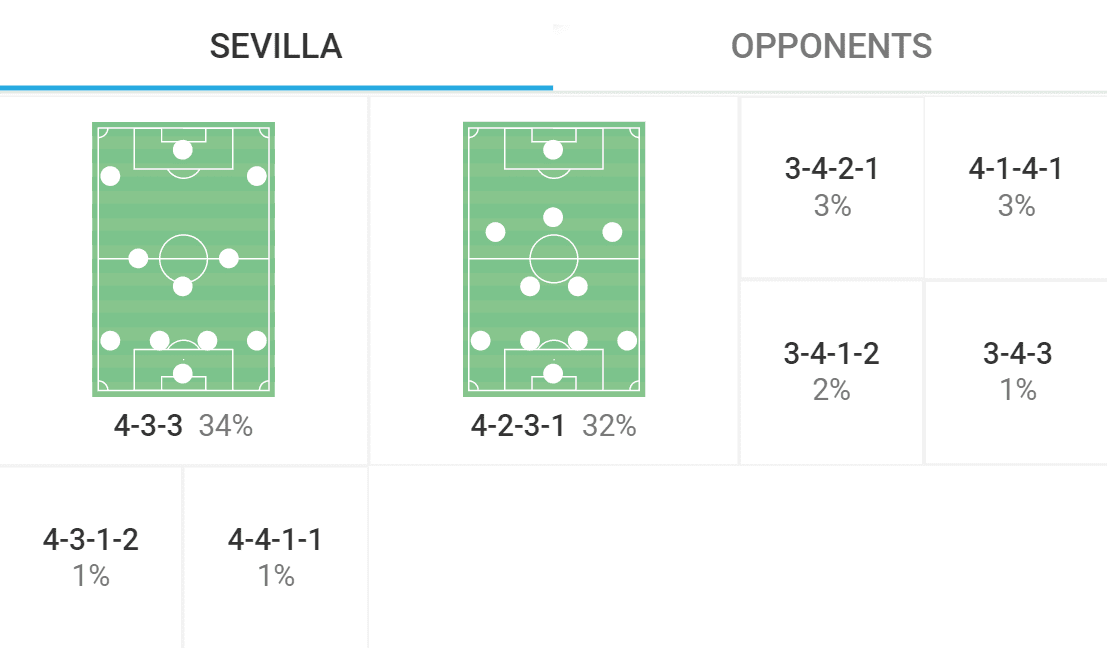
Jorge is the antidote to this.
In the 2021/22 season, his Marseille side used 12 different formations.
The 4-1-4-1 was perhaps the default one, being used 21% of the time.
Nonetheless, it constantly came with adaptations and variations.
Sampaoli brings an opposite philosophy to Lopetegui, which will undoubtedly prove a breath of fresh air for the squad.
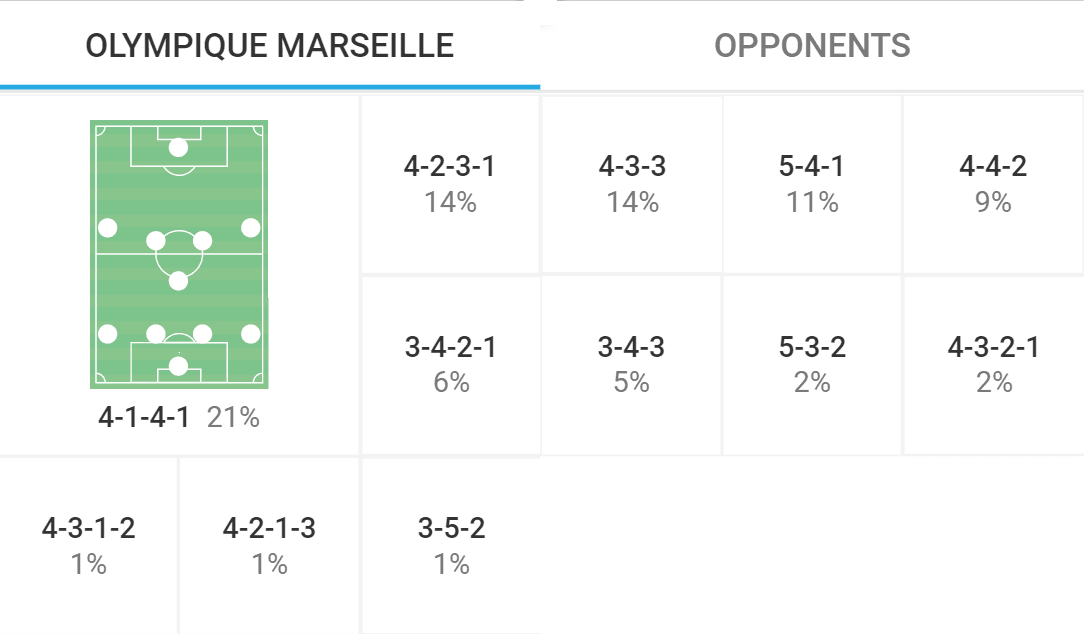
Jorge Sampaoli Principles in possession
Sampaoli’s principles in possession result in a couple of patterns.
For instance, his teams tend to dominate possession.
In 2019, with a highly underqualified Santos side, he averaged 59.96% possession.
Similarly, his Marseille last season averaged 61.17% last season.
Despite leading possession-focused sides, he still likes his teams to have a certain verticality to them.
In the Ligue 1 last season, Marseille averaged 69.13 progressive passes per 90.
More significantly, in 2019 with Santos, they averaged 80.77 progressive passes per 90.
From a broader perspective, with the ball, Sampaoli wants to engage the opposition.
After drawing them out, his teams look to progress by forming overloads, stretching the defensive organisation, strategically placing outlets, and more.
It is a rather complex network of principles and subprinciples being carried out through a specific structure heavily considerate of his players and the opposition.
One of the overarching principles is to stretch the opposition.
Through various tactics, Sampaoli’s sides aim to draw out the opposition and make them advance their defensive block.
Afterwards, they maximise the playing area in an effort to stretch the lines of pressure as much as possible.
In the example below, as the ball is played back to the goalkeeper, all three centre-backs run back to expand the playing area and stretch Montpellier’s first line of pressure.
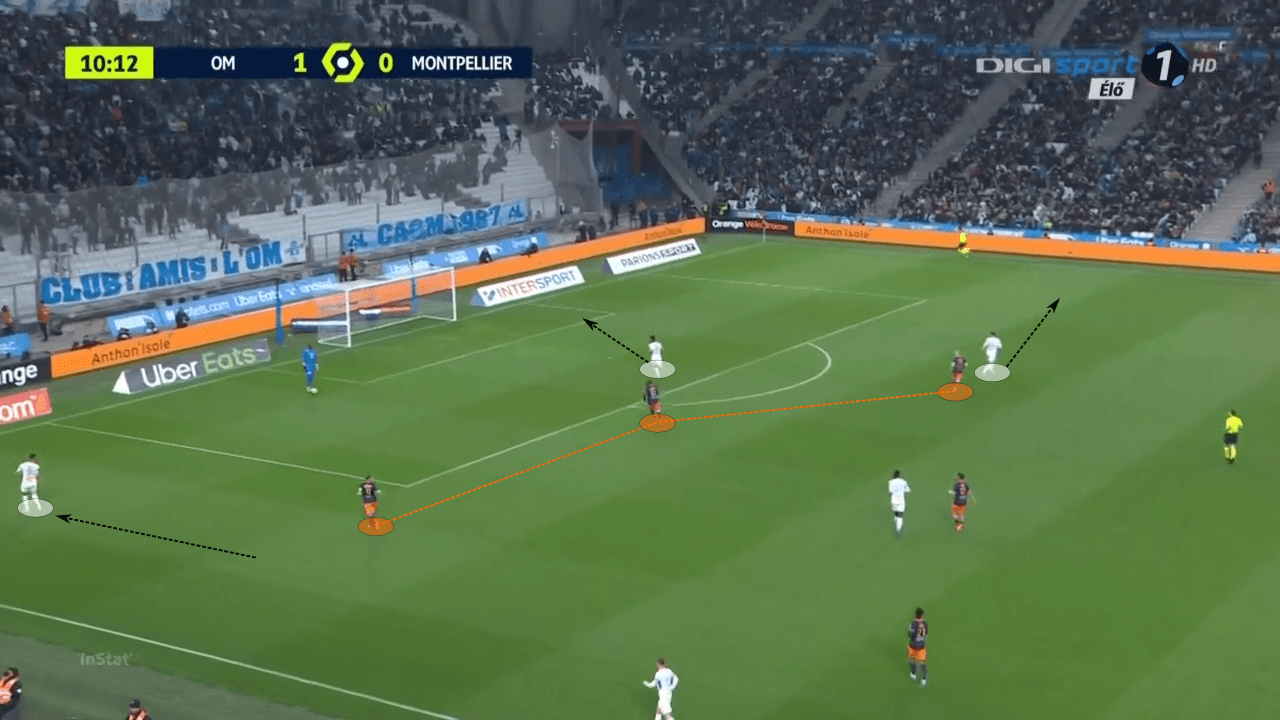
Against PAOK, we are able to see how stretching the opposition allows them to progress forward.
By having both centre-backs split the goalkeeper, PAOK’s first line of pressure is stretched.
Consequently, a passing lane is created in between the two centre-forwards.
Mattéo Guendouzi drops into this lane to receive it before progressing further.
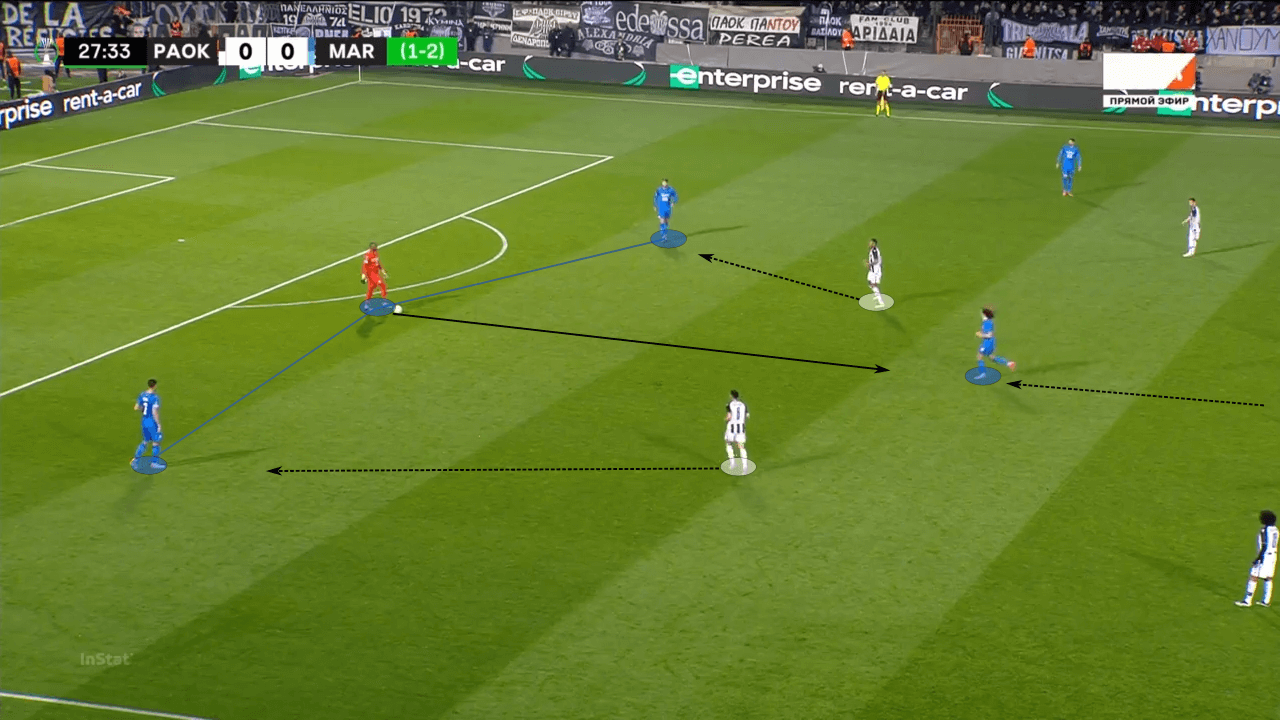
Sampaoli’s teams also possess a certain fluidity.
In football, fluidity is a term commonly used to describe tactical systems where players have more positional freedom, flowing in and out of spaces and roles.
This is especially true for teams managed by the Argentinian, as a significant number of positional rotations are used to manipulate and disorganise the opposition.
In the example below, Valentin Rongier, the right-back, drifts inside while Guendouzi, the defensive midfielder, drifts wide.
By moving centrally, Rongier drags Montpellier’s winger in and creates a passing lane on the wing for Guendouzi to move into.
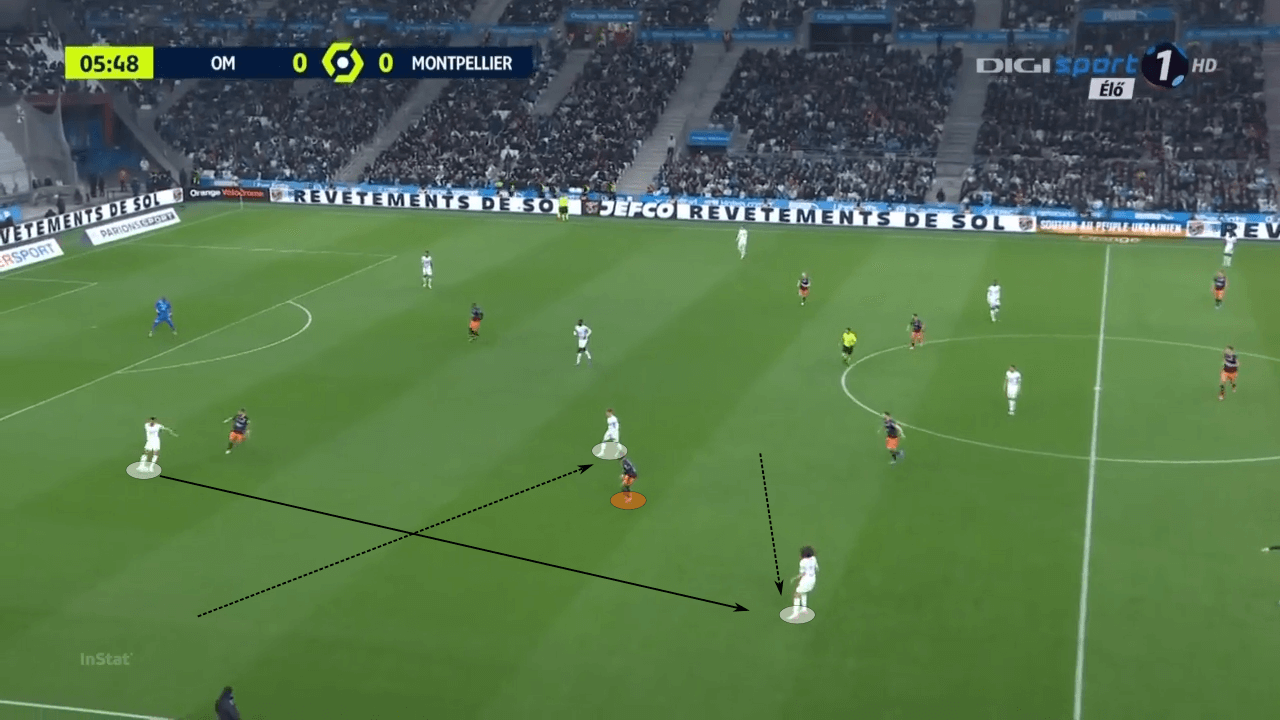
There is also significant coordination in the players’ positioning under Jorge.
His teams are constantly seeking to create overloads around the ball in order to have numerical superiority.
This is done through approximation and the creation of passing lanes, but these must be done strategically.
Jorge wants his players to position themselves in diagonal angles so as to create diagonal passing lanes.
In the example below, after creating a 4v3 scenario, the players form a diamond structure with a network of diagonal passing lanes.
These lanes break the opponent’s defensive lines.
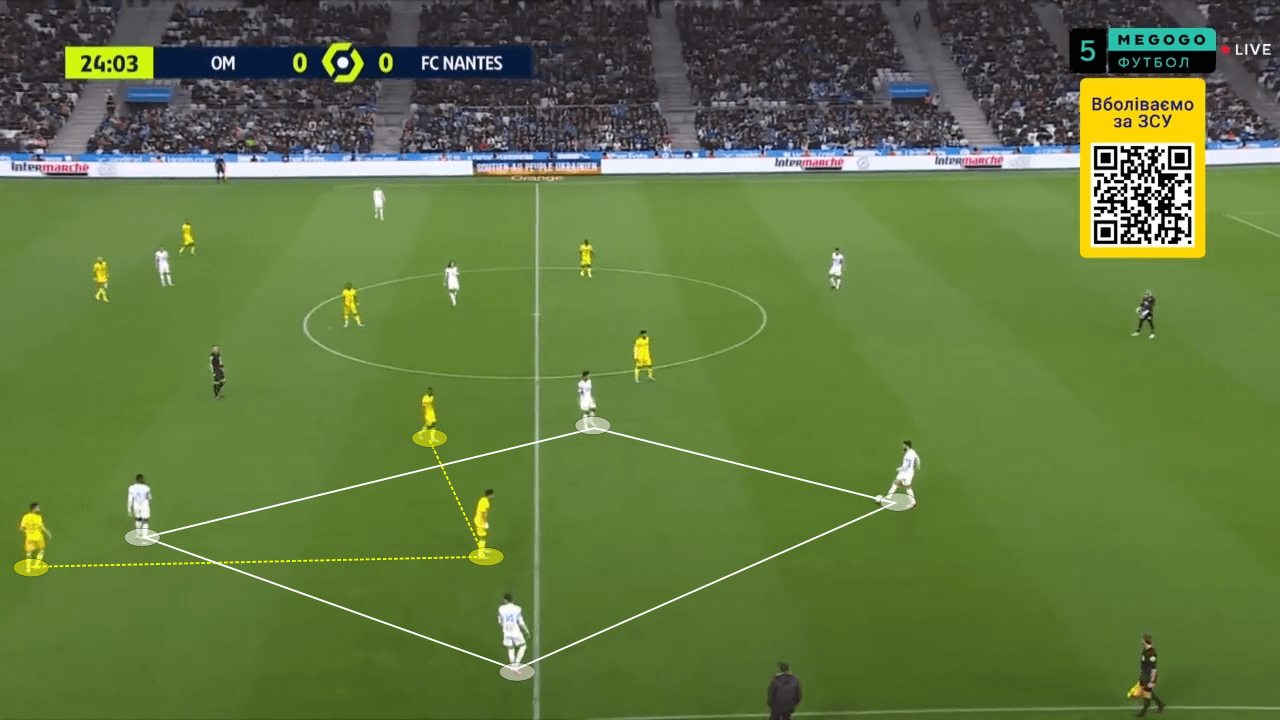
Finally, Sampaoli also wants his teams to overload the midfield.
This is not necessarily done by deploying a large number of midfielders but rather by having attackers flow in and out of central zones.
In the instance below, Dimitri Payet drops from the backline into the space between lines.
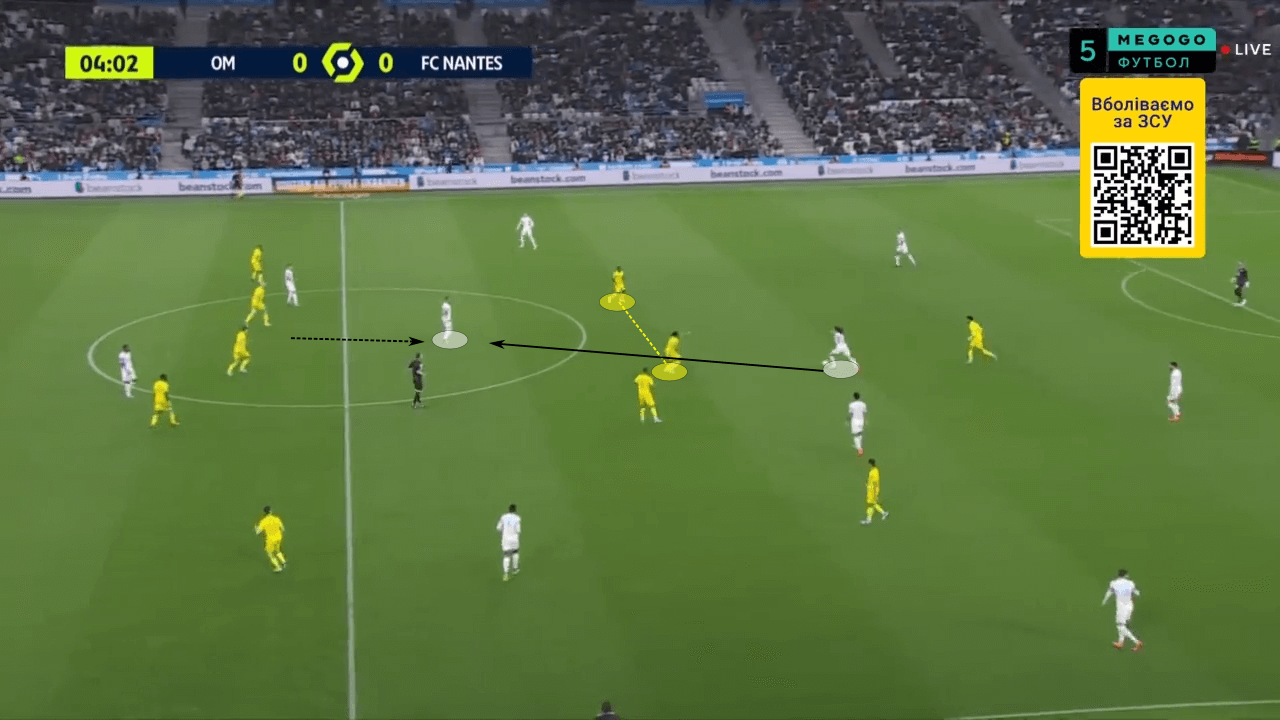
In the segment below, we see multiple of these principles working together as Marseille enters the final third.
First, Les Olympiens create a triangle in the wide area as Guendouzi offers support.
Additionally, Cengiz Ünder is hugging the touchline in order to maximise width and stretch the backline.
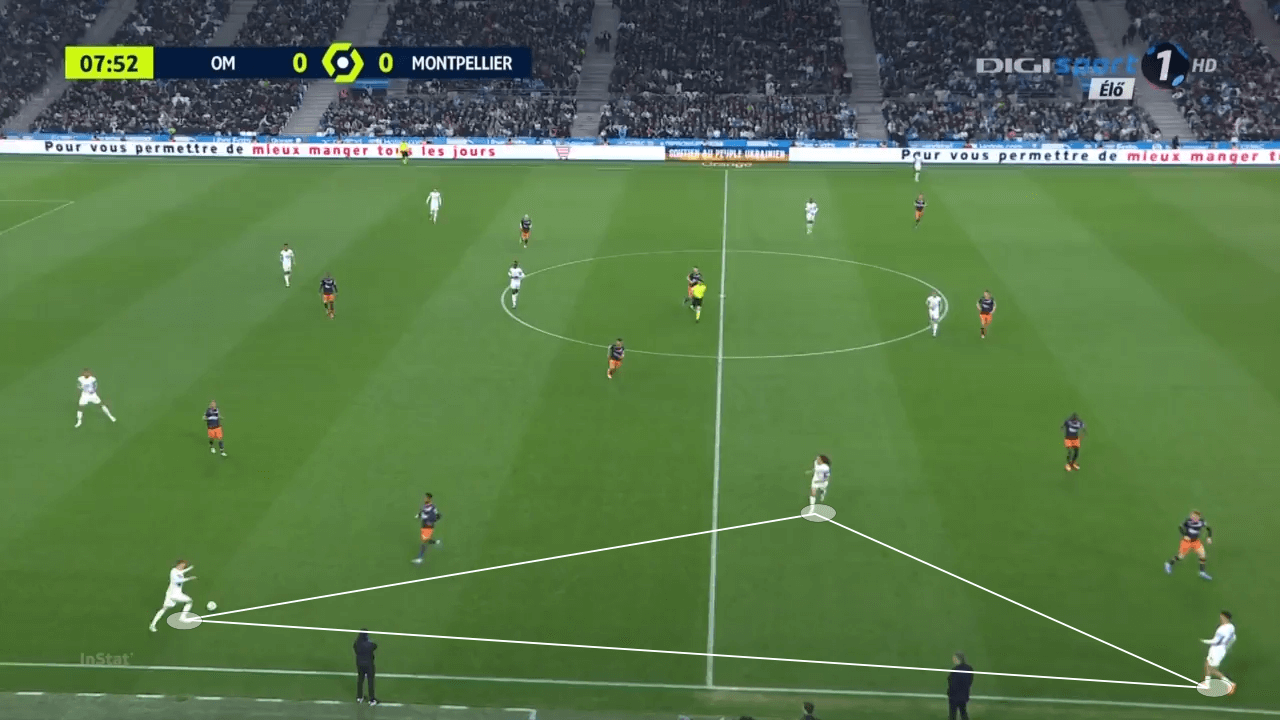
After Rongier plays it to Guendouzi, he drives inside in order to receive it back.
Meanwhile, Ünder remains wide in order to pin Montpellier’s left back.
By doing this, Ünder creates a wide lane between the centre-back and the fullback.
Once Rongier receives the ball back, Amine Harit, the centre-forward, is able to spin off the centre-back and attack this lane.
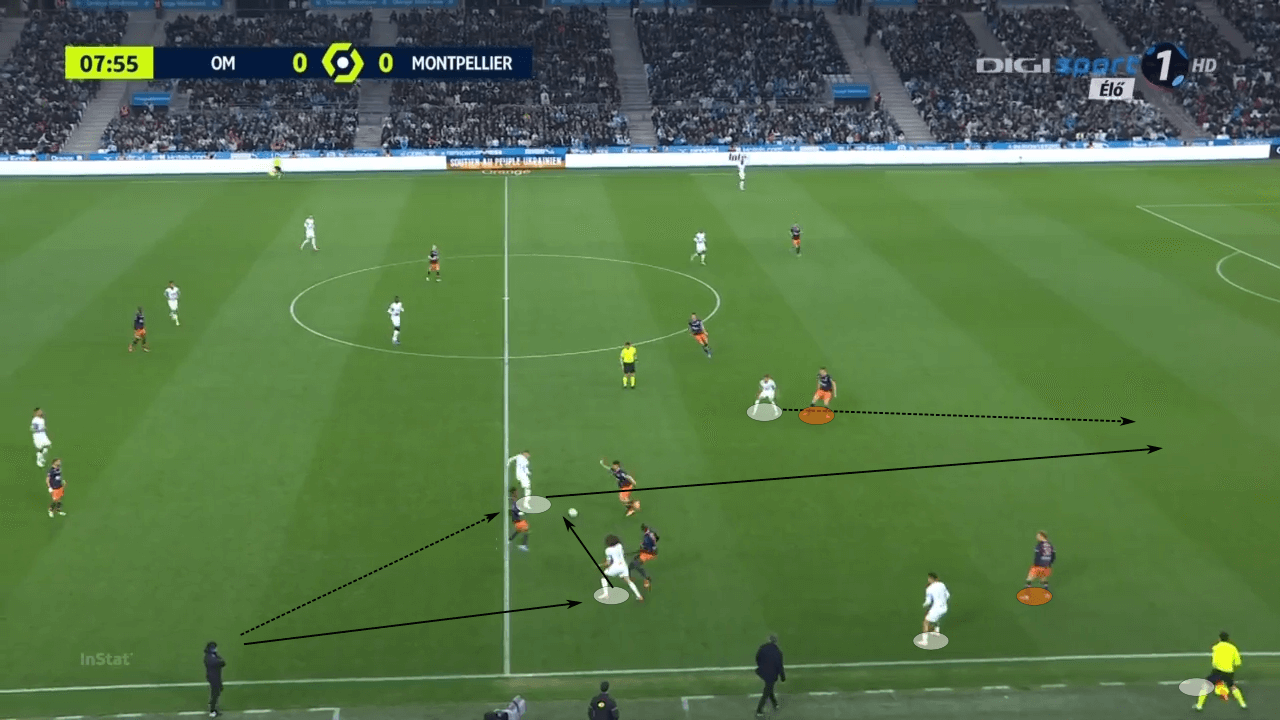
In the final third, Sampaoli wants his teams to maintain a controlled and strategic approach.
Through coordinated runs and movements, they are able to manipulate the opposition and create space within the opponent’s low block.
In the example below, the player in the half-space makes a run into the depth in order to drag the defender and create space for his teammates to drop into.
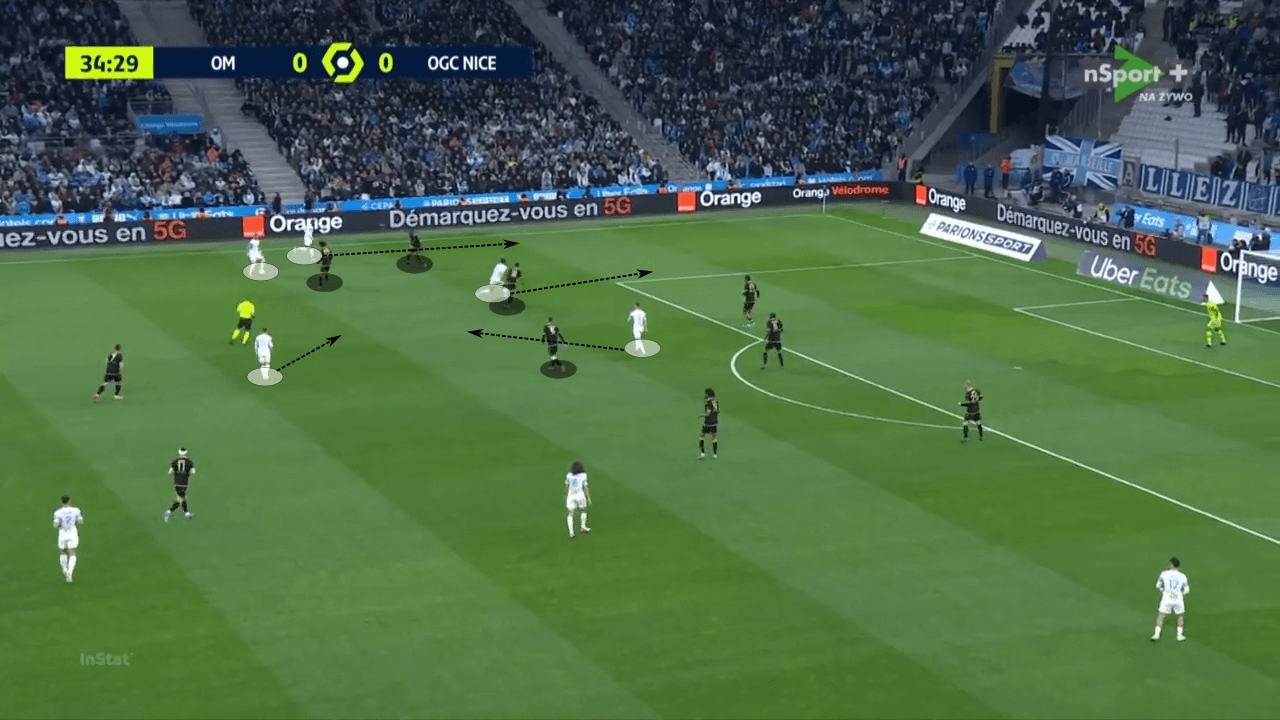
Jorge Sampaoli Defensive system
If there is one main distinction between Sampaoli and Bielsa, it is the defensive approach.
Contrary to Sampaoli’s energetic and intense personality, his teams do not press incredibly high.
In the 2021/22 season, Marseille averaged a PPDA of 11.5, far below that of PSG or Lyon.
Most often, Jorge instructs his teams to begin the defensive phase in a compact mid-block.
In this mid-block, the backline is still relatively high.
However, the first line of pressure is not far ahead.
It is a rather compact structure, without much distance between the first and the last lines.
At Marseille, a 5-2-3 was one of the most used defensive structures.
The front five, if you will, moved as a unit in an extremely compact and narrow manner.
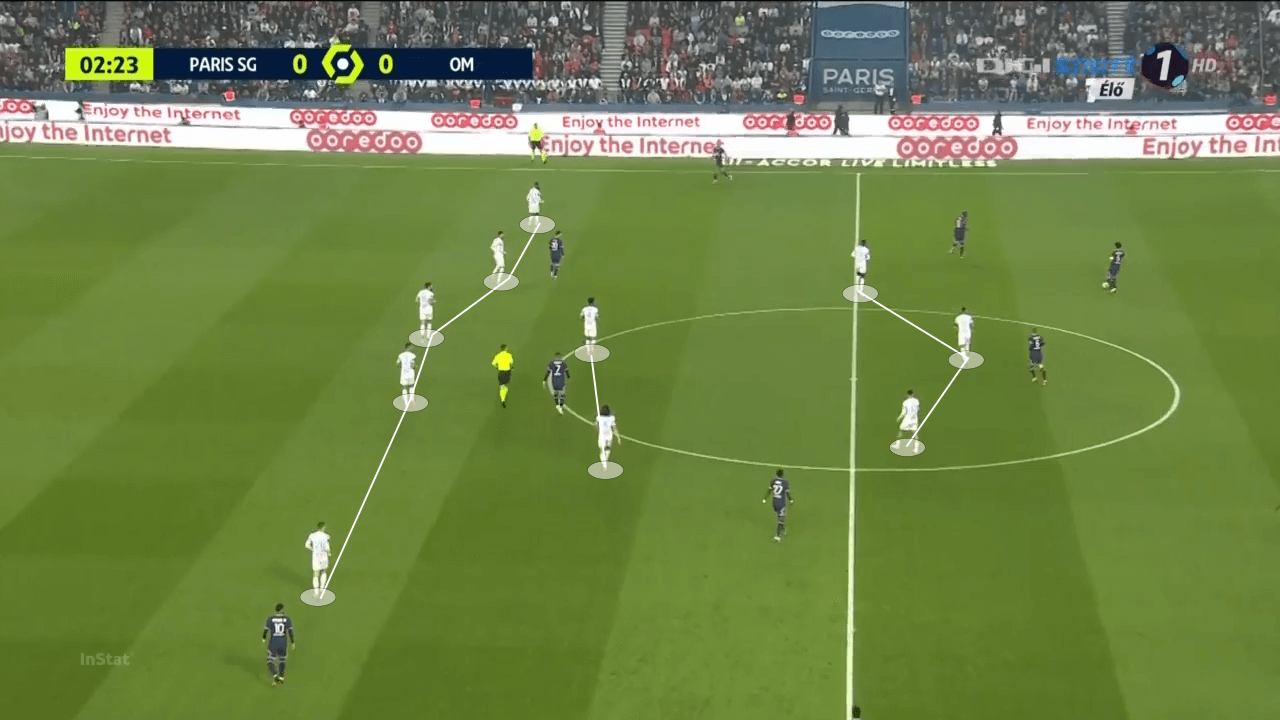
By moving as a unit, they are able to create numerical superiority in specific areas.
In the example below, as Nantes look to progress wide, Marseille shift three players and keep them from advancing.
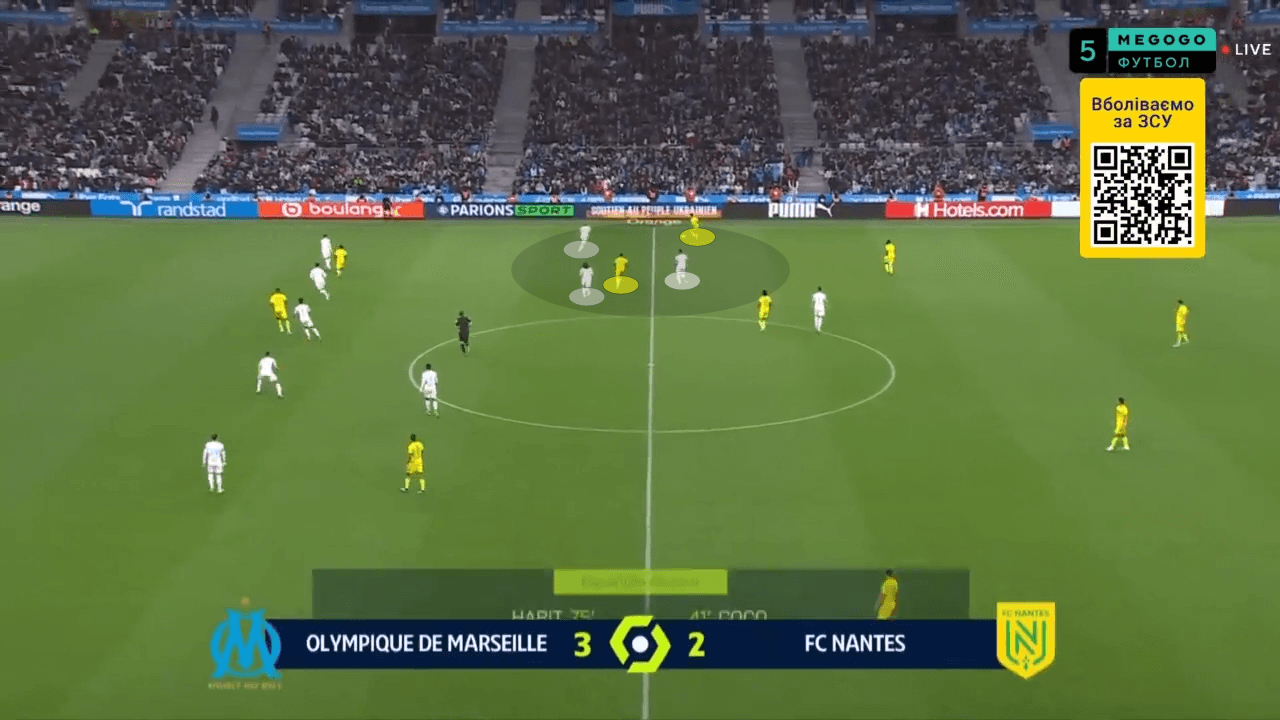
However, there is a trigger.
Although they begin in a mid-block, once the opposition begins going backwards, they
advance the height of their block and the intensity of their press.In this higher block, they adopt common pressing principles, as seen in the image below.
Most notably, they split the pitch in half to congest the playing area.
In this smaller area, they adopt a man-marking system to close down passing options.
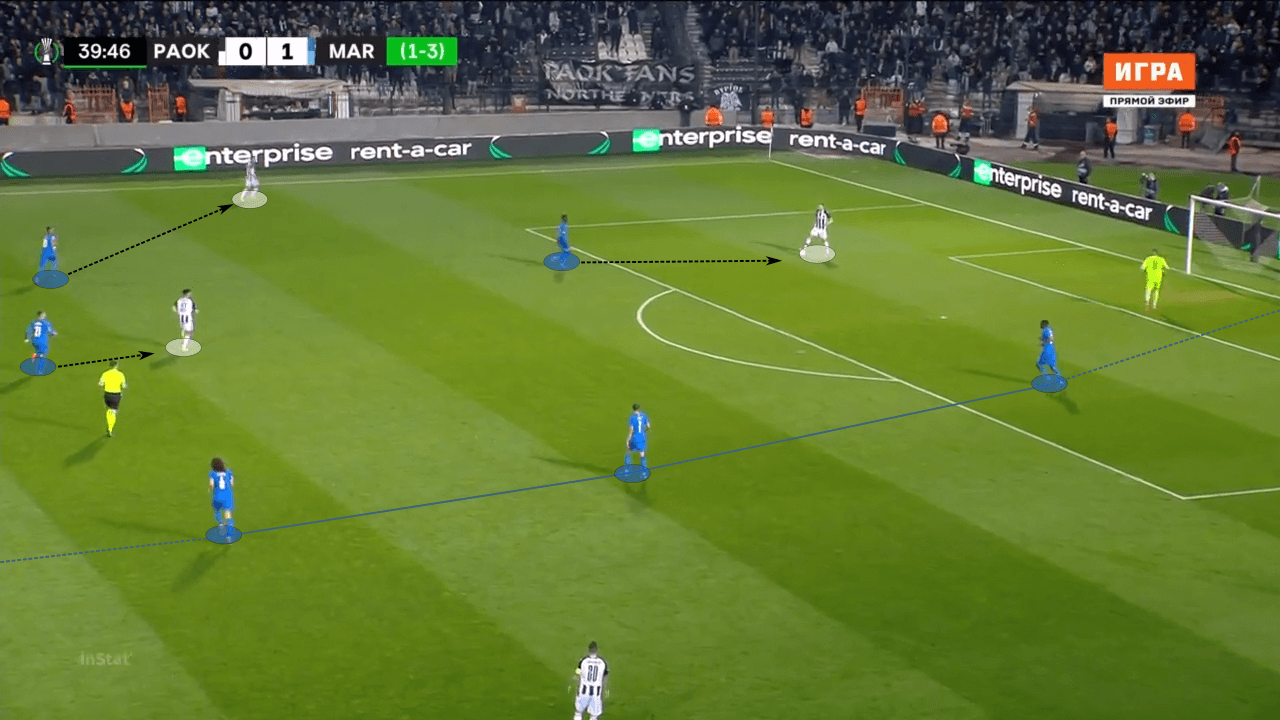
Against Nantes, their man-oriented press is highlighted further.
As Nantes begins going backwards, Sampaoli’s side advance their block and switch to a man-marking press.
By man-marking the opposition, they significantly limit the opposition’s time and space on the ball.
This tends to overwhelm the opponent and force them to get rid of the ball.
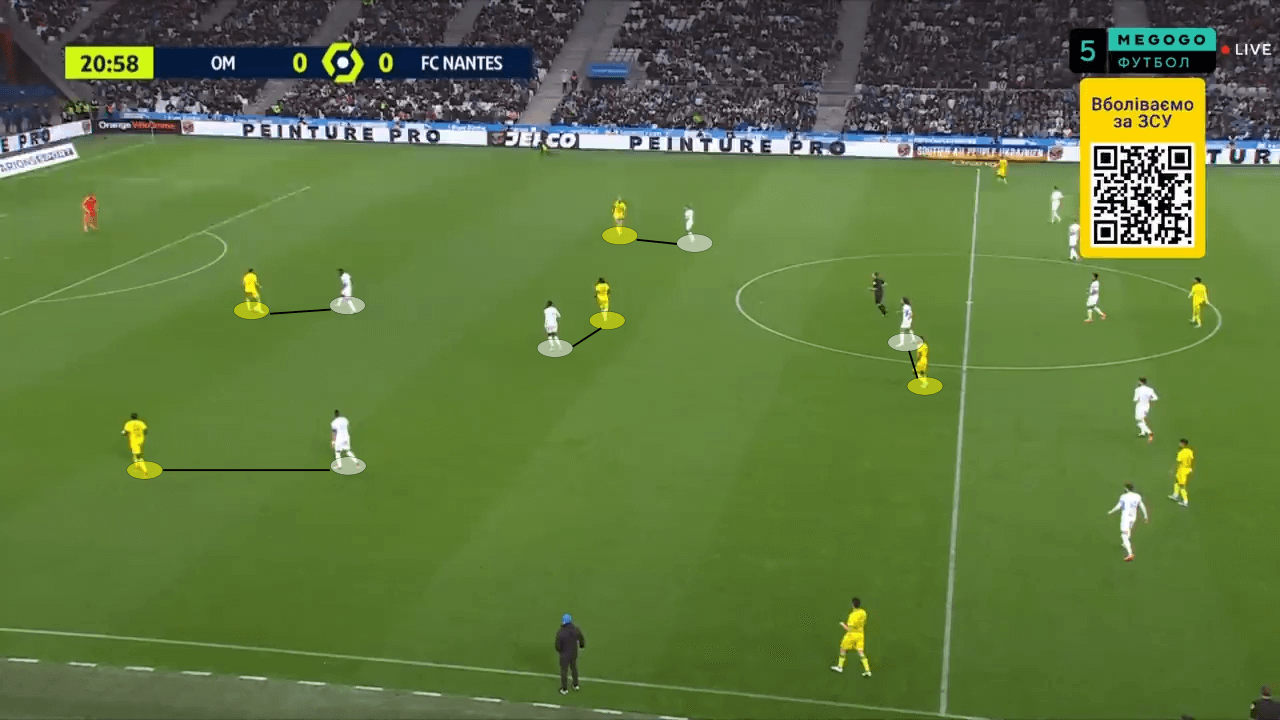
As mentioned, Sampaoli is incredibly flexible.
While Marseille defended in a 5-2-3, his Sevilla side may defend in an entirely different structure.
The structure in itself is dependent on the players at his disposal and the opposition.
Consequently, while their behaviour out of possession (compact mid-block with triggers) should be maintained at Sevilla, the formation will certainly be different.
Even in Marseille, there would be instances where Sampaoli adopted different structures.
In the second leg against PAOK, Jorge switched to a 4-1-4-1 in the mid-block.
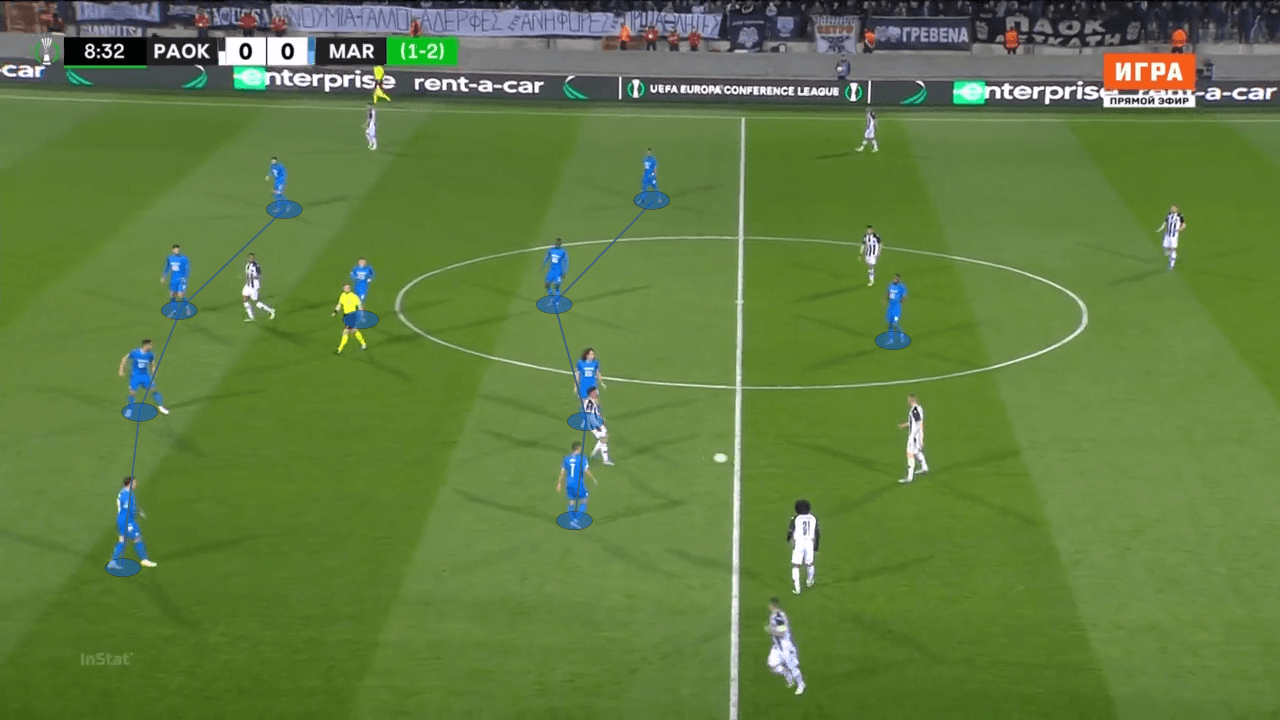
Transition to Sevilla
There will undoubtedly be a transition period in Sevilla.
As mentioned, Sampaoli brings an entirely different methodology and philosophy to Julen Lopetegui.
In addition to a different approach, the tactics are also significantly different.
While Sampaoli tends to adjust his structures and systems to his players, Sevilla’s squad will still need to adapt.
In Sampaoli’s first match in charge, Sevilla drew 1-1 with Athletic Bilbao.
In the match, Sevilla got off to an impressive start and posed a real threat to Unai Simón’s goal.
As the match went on, Bilbao reassumed control of the match and climbed back to recover a point.
Previous to the match, Sampaoli had little to no time to train and implement his ideas.
Additionally, with the UEFA Champions League leaving little time for training, it will take some time for Sampaoli to put his mark on this team completely.
Nonetheless, there were still some key tactical points to take from this match which may preview what Sevilla will look like under the Argentinian.
As far as structure, Sevilla lined up in a hybrid 4-3-3/3-4-3.
The back four was made of Gonzalo Montiel, Tanguy Nianzou, Marcão, and Alex Telles.
In the midfield, Nemanja Gudelj sat behind Óliver Torres and Joan Jordán.
Finally, the attacking trio was made of Isco, Papu Gómez, and Kasper Dolberg.
Sampaoli’s tactical flexibility was already on display as many times during the match, Gudelj dropped in between the centre-backs to form a 3-4-3.
Additionally, while initially deployed on the wings, Papu and Isco had a lot of positional freedom to create and overload the midfield.
Papu’s heatmap further highlights this.
According to Wyscout, he played as LCMF, LW, RW, and RWF all in the same match.
Gómez, especially due to his versatility, will certainly be a key piece in his fellow Argentinian’s side.
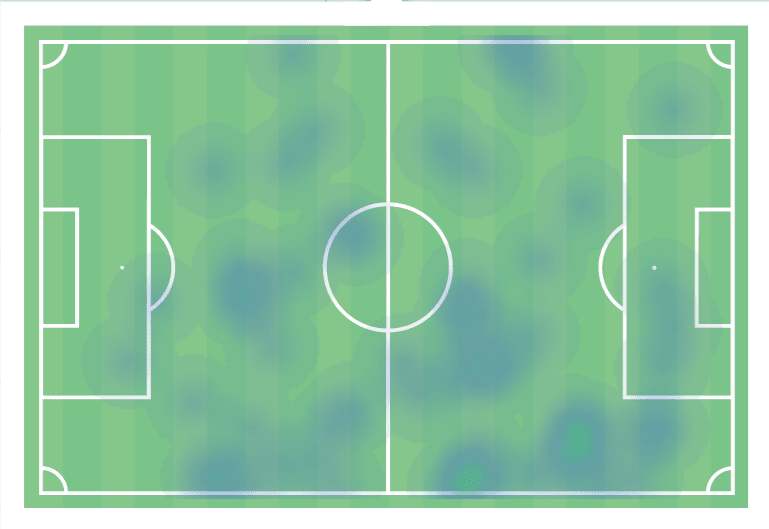
From this first match, it is also clear how important of a role the wing-backs will play.
By having Gudelj drop to form a back-three, Sampaoli gives more freedom for both fullbacks to push high.
Telles and Montiel are both extremely attacking players, and Jorge will certainly look to exploit this.
Four minutes in, Montiel underlapped Papu to cross and create the opening goal.
Montiel’s heatmap from Saturday further illustrates the attacking role Sampaoli will demand from his fullbacks.
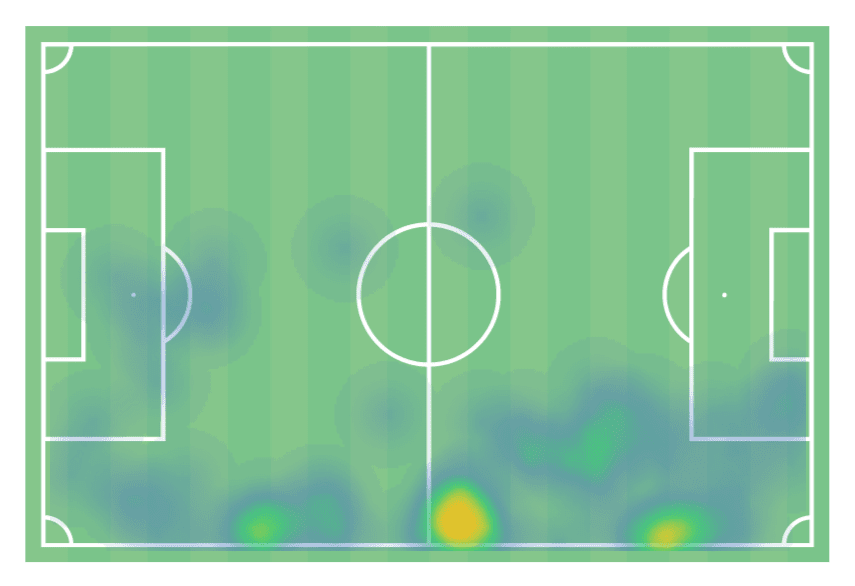
Conclusion
After three years with Lopetegui, Sevilla are now undergoing a transition period under Jorge Sampaoli.
The Argentinian manager brings a philosophy completely opposite to Sevilla’s previous manager, and it will take some time for it to be fully implemented.
Nonetheless, Sampaoli has a fascinating tactical profile, and it will be very interesting to watch Sevilla play under him.




Comments